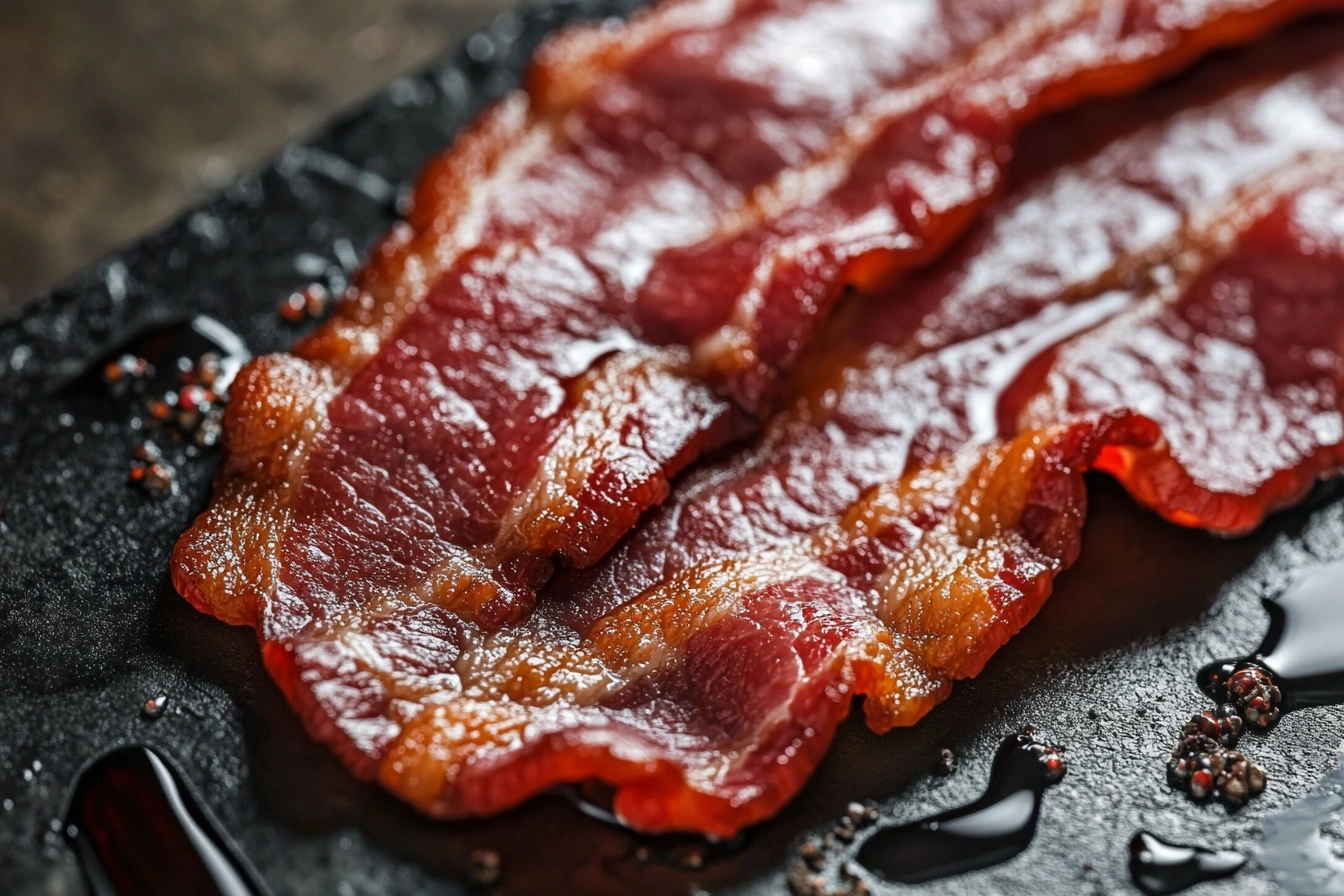Understanding Beef Bacon Calories and Nutrition
Introduction
Many people want to know how many calories are in beef bacon, especially those who follow low-carb, high-protein, or calorie-conscious diets. While pork bacon has been the traditional choice, beef bacon is gaining popularity due to dietary preferences, religious restrictions, and its unique taste.
Understanding the nutritional value of beef bacon helps individuals make informed dietary choices. Since bacon is often associated with high fat and sodium, knowing the exact calorie count can help balance it within a healthy eating plan.
When comparing beef bacon vs. pork bacon, there are some key differences in calories, fat content, and protein levels. Beef bacon is typically leaner, meaning fewer calories from fat, but it depends on the cut and preparation method. This article will break down the caloric differences, nutritional value, and how cooking methods impact calories, helping you make the best choice for your diet.
Table of Contents
How Many Calories Are in Beef Bacon?
Calories per Slice of Beef Bacon
- On average, one slice of beef bacon contains between 30 to 60 calories, depending on the brand and thickness.
- Thicker cuts tend to have more fat, increasing the calorie count.
- Lean cuts will have fewer calories per slice.
Calories per 100g of Beef Bacon
- The average calorie count for 100g of beef bacon is around 350-400 kcal, depending on fat content and processing.
Factors That Affect Calorie Count
- Fat Content – The fattier the cut, the higher the calorie count.
- Cooking Method –
- Fried beef bacon retains more fat, increasing calories.
- Baked or air-fried beef bacon allows fat to drain off, lowering calorie content.
- Cured vs. Uncured Beef Bacon –
- Cured bacon may contain added sugars or preservatives, slightly increasing calories.
- Uncured bacon is often lower in calories due to fewer additives.
By considering these factors, you can choose the best type of beef bacon for your nutritional needs.
Beef Bacon vs. Pork Bacon: Caloric Differences
Calories Per Slice: Beef Bacon vs. Pork Bacon
| Type of Bacon | Calories per Slice (Average) | Calories per 100g |
|---|---|---|
| Beef Bacon | 30-60 kcal | 350-400 kcal |
| Pork Bacon | 42-60 kcal | 400-450 kcal |
- Beef bacon can be lower in calories per slice, depending on the cut.
- Pork bacon has more fat, which increases its calorie content.
Fat Content Comparison
- Pork bacon is made from pork belly, which contains high levels of saturated fat, making it juicier but higher in calories.
- Beef bacon is made from leaner cuts, such as brisket or short plate, making it less fatty and slightly lower in calories.
- Crispy beef bacon may contain fewer calories than pork bacon because some of the fat renders out during cooking.
Protein Content
| Nutrient | Beef Bacon (per 100g) | Pork Bacon (per 100g) |
|---|---|---|
| Protein | 20-25g | 12-15g |
| Fat | 20-25g | 35-40g |
- Beef bacon is higher in protein than pork bacon, making it a great choice for high-protein diets.
Which is Better for Weight Loss or Low-Calorie Diets?
- Beef bacon is a better option if you’re looking for a leaner, high-protein alternative.
- Pork bacon has a higher fat content, making it more calorie-dense.
- If you choose turkey bacon, it will generally be the lowest in calories.
For those watching calories, choosing leaner beef bacon and baking it instead of frying is the best approach.

Nutritional Breakdown of Beef Bacon
Understanding beef bacon’s nutritional profile can help you determine how it fits into your diet.
Macronutrient Profile (Per 100g of Beef Bacon)
| Nutrient | Amount | Daily Value (%) |
|---|---|---|
| Calories | 350-400 kcal | – |
| Protein | 20-25g | High |
| Total Fat | 20-25g | Moderate |
| Carbohydrates | 0g | 0% |
Sodium Content and Its Impact on Health
- Sodium in beef bacon ranges from 300-500 mg per serving.
- High sodium intake can contribute to high blood pressure, so portion control is important.
- Opt for low-sodium or uncured beef bacon for a healthier option.
Vitamins and Minerals in Beef Bacon
- Iron – Essential for oxygen transport in the blood.
- Potassium – Helps with muscle function and hydration.
- Zinc – Supports immune function and metabolism.
While beef bacon can provide important nutrients, it should be eaten in moderation as part of a balanced diet.
How Cooking Methods Affect Calories
The way you cook beef bacon can significantly impact its calorie content.
1. Pan-Frying
- Calories: Higher
- Pan-frying retains more fat, keeping calories higher.
- If cooked without draining grease, it will absorb more fat.
2. Baking
- Calories: Lower
- Baking beef bacon at 375°F (190°C) for 12-15 minutes allows some of the fat to drip away, reducing calorie content.
- Using a baking rack helps further drain fat.
3. Air-Frying
- Calories: Lowest
- Cooking beef bacon in an air fryer at 375°F for 6-8 minutes results in the least oil absorption.
- Produces a crispy texture while reducing overall fat content.
Draining Excess Fat to Reduce Calories
- Placing cooked bacon on paper towels helps absorb extra grease, cutting calories per slice.
- Choosing leaner cuts of beef bacon results in fewer overall calories.
Using Oil or Butter: Does It Add Extra Calories?
- Adding extra butter or oil when cooking will increase calorie content.
- Using non-stick pans or baking methods can help reduce the need for added fats.
By choosing the right cooking method, you can significantly reduce calories in beef bacon while still enjoying its delicious flavor.
Health Aspects and FAQs About Beef Bacon Calories
Is Beef Bacon a Healthier Alternative?
Many people wonder if beef bacon is healthier than pork bacon, especially those following high-protein or lower-fat diets. While both have similar nutritional profiles, there are some key differences.
Higher Protein and Lower Fat Compared to Pork Bacon
- Beef bacon generally has more protein per serving compared to pork bacon, making it a great option for those on high-protein diets like keto or paleo.
- Fat content varies depending on the cut. Beef bacon made from leaner cuts like brisket or short plate has less fat than pork bacon.
Potential Health Benefits of Beef Bacon
- Higher in Iron & Zinc – Essential minerals that support immune function and metabolism.
- More Protein, Less Fat – A good alternative for those looking for a leaner bacon option.
- Pork-Free Alternative – Suitable for people who avoid pork due to religious, ethical, or dietary reasons.
Concerns About Processed Meats and Sodium Levels
- Beef bacon, like pork bacon, is processed and may contain nitrates or preservatives, which have been linked to health concerns if consumed in excess.
- High sodium content – Some brands contain over 300-500mg of sodium per slice, which can contribute to high blood pressure if eaten frequently.
Healthier Option:
Choosing uncured, nitrate-free, and low-sodium beef bacon can make it a better choice for those looking to enjoy bacon without the added health risks.
How to Include Beef Bacon in a Balanced Diet
Enjoying beef bacon in moderation can be part of a healthy, balanced diet. Here’s how to incorporate it wisely:
1. Portion Control Recommendations
- Stick to 1-2 slices per serving to avoid excess sodium and fat.
- Pair it with lean proteins, vegetables, and whole grains for a balanced meal.
2. Pairing Beef Bacon with Healthy Sides
- Breakfast: Pair beef bacon with eggs, avocado, and whole-grain toast for a nutrient-packed meal.
- Lunch: Add beef bacon to salads or wraps with fresh greens.
- Dinner: Use beef bacon as a topping for roasted vegetables or lean meats.
3. Best Diets That Incorporate Beef Bacon
- Low-Carb & Keto Diets – High protein, moderate fat, and low carbs make beef bacon a good fit.
- Paleo Diet – Uncured, nitrate-free beef bacon aligns with paleo principles.
- High-Protein Diets – A great protein source for muscle building and weight loss.
By limiting processed meats and pairing beef bacon with nutrient-rich foods, it can be part of a healthy lifestyle.

Low-Calorie Beef Bacon Brands and Alternatives
If you’re looking for a low-calorie beef bacon option, some brands offer leaner, nitrate-free alternatives.
1. Best Low-Calorie Beef Bacon Brands
- Pederson’s Natural Farms – Uncured, nitrate-free beef bacon with less sodium.
- Godshall’s Beef Bacon – Smoked, all-natural beef bacon with moderate calories.
- Applegate Naturals – Organic, grass-fed beef bacon, lower in fat and additives.
2. Alternatives to Beef Bacon
If you’re looking for a leaner or plant-based alternative, consider:
- Turkey Bacon – Lower in calories and fat, but still provides a smoky flavor.
- Plant-Based Bacon – Made from mushrooms, coconut, or tempeh, a good vegan-friendly alternative.
- Leaner Cuts of Beef Bacon – Choose brisket or sirloin-based beef bacon for a lower-fat option.
3.Homemade Beef Bacon for Better Calorie Control
Making beef bacon at home allows you to:
- Control the fat content by selecting lean cuts.
- Avoid added preservatives by using natural seasonings.
- Customize flavor with your choice of spices and smoking methods.
By choosing healthier brands or making beef bacon at home, you can enjoy bacon while keeping calorie intake in check.
FAQs Section
1. How many calories are in one slice of beef bacon?
- A single slice of beef bacon contains 30-60 calories, depending on the brand and cut.
- Thicker cuts or fattier beef bacon may have slightly higher calories.
2. How does beef bacon compare to pork bacon in calories?
| Type of Bacon | Calories per Slice | Calories per 100g |
|---|---|---|
| Beef Bacon | 30-60 kcal | 350-400 kcal |
| Pork Bacon | 42-60 kcal | 400-450 kcal |
- Beef bacon is often lower in fat than pork bacon, making it slightly lower in calories.
- Pork bacon has a higher fat content, contributing to more calories per slice.
3. Is beef bacon a good choice for weight loss?
- Yes, in moderation.
- Higher protein can keep you full longer.
- Lower fat options (leaner cuts, baked or air-fried) are better for weight loss.
4. What is the lowest-calorie way to cook beef bacon?
- Air-frying: Uses minimal oil, keeps it crispy with fewer calories.
- Baking: Allows fat to drip off, lowering overall calories.
- Pan-frying with no added fat: Cook on low heat in a non-stick pan to avoid adding extra calories.
5. Can beef bacon be part of a keto or low-carb diet?
- Yes! Beef bacon is low in carbs and high in protein, making it ideal for keto and low-carb diets.
- Pair it with avocado, eggs, and leafy greens for a nutrient-rich, low-carb meal.
By making smart cooking choices and selecting healthier cuts, beef bacon can be enjoyed guilt-free in various diets.

